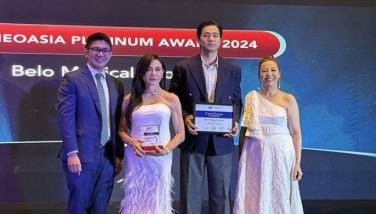Notably noted

Mind’s eye
by Paul Fleischman
Starring Joy Virata and Jenny Jamora
Carlos P. Romulo Theater,
RCBC Plaza, Makati City
If this play adapted from a novel is memorable at all, it is because Joy Virata, in a virtuoso performance, transformed it into a pulsating experience and poured into the role her decades of experience and artistry. She is truly one of our greatest actresses today. Sure, she played the role in English, which only goes to prove that our actors and actresses are great achievers whether they are reciting lines in English or Tagalog.
The plot of the play will have limited appeal to an audience not steeped in the humanities, particularly literature and history; it is about an old literature teacher who tutors a teenager paralyzed from the waist down, the triumph of the creative imagination over a grim reality. Using an old guidebook on Italy, she urges her hospital roommate to read it aloud. She helps her to envision the physical reality of the place and, in the process, endows her young and reluctant reader with the romance of history and literature. In this sense, it is also how art makes a hobbled life worthwhile. This ennobling theme may be missed by an audience enamored of the baubles of consumerism. In other words, it is not just imagination as lived in the mind but how that bleak real world can be accepted, lived with, and how it can be changed.
Joy Virata is, of course, the wife of that former public servant and paragon, Cesar Virata. He met her when she was his student at the University of the Philippines.
A singer of classical music, she was a pillar of the theater group, Repertory Philippines, which she joined in 1976. She had acted, and supervised, so many of the Repertoire’s many productions. She also authored the musical and lyrics of Miyong, based on the life of General Emilio Aguinaldo who was her husband’s relative.
Jenny Jamora who plays the role of the teenager immobilized by an accident for all her youth is a seasoned actress who has performed here and abroad in international productions. Her dazzling performance in this play assures her more kudos in the future.
If I directed the play, I would have abridged it a bit to give it more dramatic tension. I would have an austere minimalist set to heighten imaginative nuance: three simple hospital beds, a wheelchair, chest, and an old TV set and a dark gray background which brightens up as the play moves forward to its denouement.
This is nitpicking. I recommend this play to devotees of the theater, our deracinated youth and old teachers and hacks like myself.
* * *
Under the Stacks
by Saul Hofilena
Manila, 2011, 460 pages
Saul Hofileña, outstanding lawyer, teacher, art collector and cognoscenti of the good life, is also vastly interested and involved with Philippine history. Through the years, among other things, in his travels and forays in those nooks and crannies only fastidious collectors know, he has gathered rare books, mementos, papers and even original documents about people and events which record and construct what we call our national narrative.
Now he has turned to writing, using not just what he has in his hands as material sources, but recollecting as well his conversations with historians and those individuals who he knows are creators of our history the big men he has met in his law practice, in his social interactions, and in his catholic reading that has led him to antiquarian and exotic bookshops
Excellent lawyers easily make excellent writers. There is that element in their legal training that equips them with the facility to express themselves very well, whether lucidly or obscurely as the situation may demand.
There is none of that obfuscating and boring legalese in these well-researched expositions all are clear and sometimes even bone dry in the author’s effort to be historically accurate.
Take for instance collaboration with the Japanese in World War II. That heart-wrenching issue which roiled Filipinos immediately after World War II continues to eddy around us this very day, challenging the sturdiness and fortitude of our moral values. Hofileña’s findings on the Makapili and Bisigbakal two Filipino-inspired organizations that collaborated with the Japanese and caused the murder of many Filipinos illustrate the ethical nadir of the collaborators. It reminds us, too, how self-destructive errant nationalism can be.
At the same time, although Hofileña does not explicitly make it a conclusion, the justice system and the Filipino leaders soon after the war glossed over the collaboration issue, even going so far as to declare an amnesty on the guilty; so many of them belonged to the upper classes and to penalize them would disturb the social equilibrium as dominated by those who were also the judges and lawmakers. So much then for morality as an iron determinant in the definition of collaboration with the enemy.
Likewise, Hofileña recalls for us and for our anthropologists in particular that penchant in the 19th century of physical anthropologists to measure the brain and conclude that brain size in itself was the measure of intelligence among a race or ethnic group. Here again, Hofileña posits the archaic colonialist view to rationalize and justify colonialism perhaps not blatantly concluded as such, but perniciously implied.
The topics with Hofileña chipped from the huge story of this country may be considered trite but are truly important pieces that need retelling. Remember that poem about how a kingdom was lost? It started with this line: “For want of a nail, the shoe was lost.” No analogy is intended here, only the possibility that one forgotten or misplaced piece if found may complete the big picture or explain the continuum that is the present.
Taken singly, what Saul Hofileña has retrieved from his collection of historical materials may appear to us as insignificant trivia. These precious nuggets from our past, however in themselves and collectively impart to us a better understanding of ourselves and priceless insights in the creation of our nation.
* * *
Agueda: A Ballad of stone and wind
by Anna Maria L. Harper
UST Publishing House, 2012, 251pages
Reading a novel, even a very good one like Bambi Harper’s first novel, takes time, effort and we are not under any obligation to read, much more finish, one. But we must as did the ancients long before us, for literature the noblest of the arts does not only entertain but also ennobles us. More than this, literature teaches us ethics, which we can never learn even if we are academically immersed in theology and cosmology for years. The depiction of basic human problems in literature enables us to distinguish right from wrong, to empathize with the oppressed.
If contextual, literature also tells our story as a people, as members of a community; it creates a sense of identity that should unite us, and reinforces memory, without which there is no nation.
We need more historical novels such as Bambi’s. The novelists who write them perform a function beyond what it is normally associated with literature. Agueda is historical and it will last a long, long time, as do the classics ars longa vita brevis!
Let me cite my own experience from which you may learn. I have had difficulties working on my historical novels. Most historians, concerned as they are with the big picture, do not bother with those little details that are part of daily life. For instance, were there pencils already at the end of the 18th century? What supplies did the Americans bring to the Philippines when they came in 1898? I would be buried in a history book for a week, then realize that I could only extract a paragraph from it. I gathered so much historical material, and my imagination would become hobbled by this glut. You may now avoid this mistake; Robert Graves, the English poet and writer, had this beautiful advice, which I learned too late: Write the novel first; do the research afterwards.
I can only surmise the tremendous research that Bambi did with this, her first novel. It is all there, so authentic, you can imagine the scenes as if you are living them.
We can also learn from Bambi’s narrative the why and wherefores of this nation, for this is what literature does explains our past, who we were and what we are now. In knowing ourselves, we should then be able to strengthen ourselves as we lift this people and nation from the ignominious rubble of history.
For this singular achievement, let us welcome Bambi into the ranks of our distinguished writers.




















